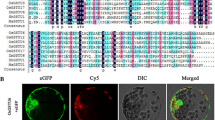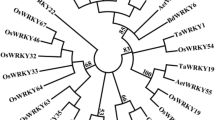Abstract
Cadmium damages rice cells and affects rice yield and quality. Glutathione S-transferase (GST) plays a diverse role in plant responses to cadmium stress by binding exogenous toxic molecules to glutathione (GSH). Here, we identified two new GST genes, OsGSTU5 and OsGSTU37, and found that their transcripts were induced by cadmium. Yeast cells containing OsGSTU5 or OsGSTU37 displayed high tolerance to cadmium. The seed germination rate, seedling growth and the survival rate under cadmium stress were improved in OsGSTU5- or OsGSTU37-overexpressing lines. In contrast, CRISPR/Cas9-mediated OsGSTU5 or OsGSTU37 knockout lines showed cadmium-hypersensitive phenotypes. Physiological analysis showed that the activities of antioxidant enzymes and glutathione reductase were increased in OsGSTU5-OE and OsGSTU37-OE, which enhanced their tolerance to cadmium. In conclusion, OsGSTU5 and OsGSTU37 are involved in the regulatory mechanism of cadmium tolerance in rice.




Similar content being viewed by others
Data availability statement
The data that support the findings of this study are available from the corresponding author, upon reasonable request.
References
Alici E, Arabaci G (2016) Determination of sod, pod, ppo and cat enzyme activities in rumex obtusifolius l. Annu Res Rev Biol 11(3):1–7
Ankita T, Yuvraj I, Madhu T, Poonam T, Dipali S, Pankaj KV, Shikha V, Neelam G, Debasis C (2014) Transformed yeast (Schizosaccharomyces pombe) overexpressing rice Tau class glutathione-S-transferase (OsGSTU30 and OsGSTU41) shows enhanced resistance to hexavalent chromium. Metallomics 6:1549–1557
Chen H, Nelson RS, Sherwood JL (1994) Enhanced recovery of transformants of Agrobacterium tumefaciens after freeze-thaw transformation and drugselection. Biotechniques 16:664–670
Chen G, Hu J, Lian J, Zhang Y, Qian Q (2019) Functional characterization of oshak1 promoter in response to osmotic/drought stress by deletion analysis in transgenic rice. Plant Growth Regul 88(3):241–251
Chui C, Li H, Li J, Qin R, Xu R, Yang Y, Ma H, Song FS, Li L, Wei P, Yang J (2015) Isolation and characterization of three cadmium-inducible promoters from Oryza sativa. J Biotechnol 216:11–19
Daisei U, Naoki Y, Izumi K, Chao FH, Tsuyu A, Masahiro Y, Jian FM (2010) Gene limiting cadmium accumulation in rice. Proc Natl Acad Sci 107(38):16500–16505
Duan Y, Zhai C, Li H, Li J, Mei W, Gui H, Ni D, Song F, Li L, Zhang W, Yang J (2012) An efficient and high-throughput protocol for Agrobacterium-mediated transformation based on phosphomannose isomerase positive selection in Japonica rice (Oryza sativa L.). Plant Cell Rep 31:1611–1624
Duan YB, Li J, Qin RY, Xu RF, Li H, Yang YC, Yang JB (2015) Identification of a regulatory element responsible for salt induction of rice osrav2 through ex situ and in situ promoter analysis. Plant Mol Biol 90(1–2):49–62
Duan PG, Xu JS, Zeng DL, Qian Q (2017) Natural variation in the promoter of gse5 contributes to grain size diversity in rice. Mol Plant 10(5):685–694
Guo JB, Xu WZ, Ma M (2012) The assembly of metals chelation by thiols and vacuolar compartmentalization conferred increased tolerance to and accumulation of cadmium and arsenic in transgenic Arabidopsis thaliana. J Hazard Mater 1(199–200):309–313
Hasanuzzaman M, Nahar K, Anee TI, Fujita M (2017) Glutathione in plants: biosynthesis and physiological role in environmental stress tolerance. Physiol Mol Biol Plants 23(2):249–268
Hu TZ, Qv XX, Xiao GS, Huang XX (2009) Enhanced tolerance to herbicide of rice plants by over-expression of a glutathione S-transferase. Mol Breed 24:409–418
Jain M, Ghanashyam C, Bhattacharjee A (2010) Comprehensive expression analysis suggests overlapping and specific roles of rice glutathione S-transferase genes during development and stress responses. BMC Genom 11(1):73
Jan S, Parray JA (2016) Metal tolerance strategy in plants, chap 2. Springer, Singapore, pp 19–32. https://doi.org/10.1007/978-981-10-1693-6
Kaya C, Ashraf M, Alyemeni MN, Ahmad P (2019) The role of endogenous nitric oxide in salicylic acid-induced up-regulation of ascorbate-glutathione cycle involved in salinity tolerance of pepper plants. Plant Physiol Biochem 147:10–20
Kumar S, Asif MH, Chakrabarty D, Tripathi RD, Dubey RS, Trivedi PK (2013) Expression of a rice lambda class of glutathione s-transferase, osgstl2, in arabidopsis provides tolerance to heavy metal and other abiotic stresses. J Hazard Mater, pp 248–249.
Kumar P, Purty RS (2021) Nature of the tapetum-specific promoter is crucial for generation of rice transgenics possessing a lethal barnase gene. J Crop Sci Biotechnol 24:579–584
Moons A (2003) Osgstu3 and osgtu4, encoding tau class glutathione S-transferases, are heavy metal and hypoxic stress-induced and differentially salt stress-responsive in rice roots. Febs Lett 553(3):427–432
Namiko S, Mikako M, Nobushige N, Tomohiko K, Yasuo N, Kenji S, Hidekazu T, Akio W, Hiromori A (2012) Mutations in Rice (Oryza sativa) Heavy Metal ATPase 2 (OsHMA2) Restrict the Translocation of Zinc and Cadmium. Plant Cell Physiol 53(1):213–224
Naoki Y, Akimasa S, Ji X, Kengo Y, Jian F (2013) A node-based switch for preferential distribution of manganese in rice. Nat Commun 4(9):2442
Nezhad RM, Shahpiri A, Mirlohi A (2013) Heterologous expression and metal-binding characterization of a type 1 metallothionein isoform (OsMTI-1b) from rice (Oryza sativa). Protein J 32(2):131–137
Potters G, Horemans N, Jansen MA (2010) The cellular redox state in plant stress biology-a charging concept. Plant Physiol Biochem 48(5):292–300
Salt DE, Prince RC, Pickering IJ, Raskin I (1995) Mechanisms of cadmium mobility and accumulation in Indian mustard. Plant Physiol 109(4):1427–1433
Satoru I, Yasuhiro I, Masato I, Masato K, Tadashi A, Takeshi S, Yoshihiro H, Tomohito A, Naoko K, Nishizawa H (2012) Ion-beam irradiation, gene identification, and marker-assisted breeding in the development of low-cadmium rice. Proc Natl Acad Sci 109(47):19166–19171
Servane BB, Maik R, Montserrat S (2017) Targeted promoter editing for rice resistance to xanthomonas oryzae pv. oryzae reveals differential activities for sweet14-inducing tal effectors. Plant Biotechnol J 15:306–317
Shah K, Nahakpam S (2012) Heat exposure alters the expression of sod, pod, apx and cat isozymes and mitigates low cadmium toxicity in seedlings of sensitive and tolerant rice cultivars. Plant Physiol Biochem, p 57.
Song X, Meng X, Guo H, Cheng Q, Jing Y, Chen M, Yu H (2022) Targeting a gene regulatory element enhances rice grain yield by decoupling panicle number and size. Nature Biotechnol, pp 1–9.
Sun W (2010) Study on the structure and function of rice OsGSTU1 protein. Graduate University of Chinese Academy of Sciences.
Tsuchiya T, Takesawa T, Kanzaki H, Nakamura I (2004) Genomic structure and differential expression of two tandem-arranged GSTZ genes in rice. Gene, pp 141–149.
Wojcik M, Anna T (2004) Phytochelatin synthesis and cadmium localization in wild type of Arabidopsis thaliana. Plant Growth Regul 44(1):71–80
Wojcik M, Tukiendorf A (2011) Glutathione in adaptation of Arabidopsis thaliana to cadmium stress. Biol Plantarum 55(1):125–132
Xu RF, Li H, Qin RY, Li J, Qiu CH, Yang YC, Wei PC, Yang JB (2015) Generation of inheritable and “transgene clean” targeted genome-modified rice in later generations using the crispr/cas9 system. Sci Rep 5:11491
Xu N, Chu L, Chen H, Li X, Wu Q, Jin L, Wang G, Huang J (2018) Rice transcription factor OsMADS25 modulates root growth and confers salinity tolerance via the ABA–mediated regulatory pathway and ROS scavenging. PLoS Genet 14(10):e1007662
Yang X, Sun W, Liu JP, Liu YJ, Zeng QY (2009) Biochemical and physiological characterization of a tau class glutathione transferase from rice (Oryza sativa). Plant Physiol Biochem 47:1061–1068
Yang X, Wei J, Wu Z, Gao J (2020) Effects of substrate-binding site residues on the biochemical properties of a tau class glutathione s-transferase from oryza sativa. Genes 11(1):25
Zhang Y, Jin L, Feng S, Liu J, Chai T (2013) Effects of cadmium on the activity of antioxidant enzymes and gene expression of the cadmium hyperaccumulating plant Solanum vulgaris. J Grad School Chin Acad Sci 30(1):11–17
Zhang H, Zhou JF, Kan Y, Shan JX, Ye WW, Dong NQ, Lin HX (2022) A genetic module at one locus in rice protects chloroplasts to enhance thermotolerance. Science 376(6599):1293–1300
Acknowledgements
The authors wish to thank all who assisted in conducting this work.
Funding
The study was supported by Natural Science Foundation of Anhui Province (Grant Number 18080885MC66), the Key research and development projects in Anhui Province (Grant Number 202104b11020008), the Major Research Projects in Anhui Province (Grant Number 2021d06050002) and the Program of Rice Genetic Breeding Key Laboratory of Anhui Province (Grant No. SDKF-2022-03).
Author information
Authors and Affiliations
Corresponding author
Ethics declarations
Conflict of interest
The authors declare no conflict of interest.
Additional information
Editorial responsibility: Jing Chen.
Supplementary Information
Below is the link to the electronic supplementary material.
Rights and permissions
Springer Nature or its licensor holds exclusive rights to this article under a publishing agreement with the author(s) or other rightsholder(s); author self-archiving of the accepted manuscript version of this article is solely governed by the terms of such publishing agreement and applicable law.
About this article
Cite this article
Yang, Y., Li, J., Li, H. et al. OsGSTU5 and OsGSTU37 encoding glutathione reductases are required for cadmium tolerance in rice. Int. J. Environ. Sci. Technol. 20, 10253–10260 (2023). https://doi.org/10.1007/s13762-022-04550-9
Received:
Revised:
Accepted:
Published:
Issue Date:
DOI: https://doi.org/10.1007/s13762-022-04550-9




